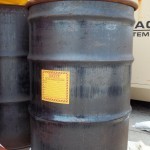If you discard anything from your home, business, or government office you are a generator of a solid waste. As a generator of solid waste you are required to conduct a Hazardous Waste Determination to determine if your solid waste is subject to regulation – perhaps it is conditionally excluded from regulation as a hazardous waste if it is a Household Hazardous Waste – and what kind of hazardous waste it is (Listed, Characteristic, or both).
Note: As of the effective date of the Generator Improvements Rule on May 30, 2017 the Federal regulations referenced in this article have changed. The USEPA regulations for counting of hazardous waste to determine generator category are now found at 40 CFR 262.17(a)(7). The regulations of your state may still refer to the original location of the Federal regulations. I have written an article to address the new regulations for counting of hazardous waste and determination of generator category. |
Once you have identified the hazardous waste you generate you are required to determine your hazardous waste generator status. This is important since compliance with the RCRA regulations of the USEPA and your state will depend on your hazardous waste generator status. It’s no surprise that the higher your hazardous waste generator status, the greater your regulatory burden. The purpose of this article is to provide guidance in determining what wastes to consider and count when you are determining your hazardous waste generator status for the purpose of compliance with the RCRA regulations.
Not sure of your hazardous waste generator status? |
Do consider the following for the purposes of determining your hazardous waste generator status
All quantities of listed and characteristic hazardous waste that are…
- Accumulated on the property for any period of time before disposal or recycling. For example: residue removed from a storage tank or process and spent solvents.
- Shipped off-site for disposal, treatment, or recycling.
- Treated or disposed of on-site in a permitted treatment or disposal unit.
- Generated as still bottoms or sludges and removed from product storage tanks.
Don’t consider the following for the purposes of determining your hazardous waste generator status

Wastes that…
- Residue remaining in a RCRA Empty container.
- Residue remaining in a product storage tank as long as the residue is not removed from the tank and the tank is not out-of-service for >90 days. Read more about the Manufacturing Process Unit Exclusion.
- Are reclaimed continuously on-site without storage prior to reclamation.
- Are managed in an elementary neutralization unit, a totally enclosed treatment facility, or a wastewater treatment facility without storage prior to treatment.
- Are discharged directly to a Publicly Owned Treatment Works (POTW) without prior storage or accumulation. The discharge to a POTW must comply wit the Clean Water Act (CWA).
- Have already been counted once during the calendar month and are treated on-site or reclaimed in some manner to be used again.
- Meet the definition and requirements of the regulations for used oil, lead-acid batteries that are being reclaimed, scrap metal being recycled, or universal wastes.
Daniels Training Services 815.821.1550 |
After you’ve determined your hazardous waste generator status, contact me for the training required by both state and federal regulations.
